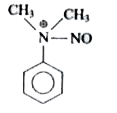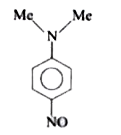N, N-Dimethylaniline is treated with aqueous NaNO2/HCl, the product formed is
p-(N, N-dimethylamino) benzenediazonium chloride.
p-(N, N-dimethylamino) phenol
p-nitroso-N,N-dimethylaniline
p-nitro-N,N-dimethylaniline
To solve the problem of what product is formed when N,N-Dimethylaniline is treated with aqueous NaNO2/HCl, we can follow these steps:
Step 1: Understand the Reactants
N,N-Dimethylaniline is an aniline derivative where the nitrogen atom is bonded to two methyl groups (–CH3). The structure can be represented as follows:
CH3∣C6H5−N−CH3
Step 2: Identify the Reaction Conditions
The reaction involves treating N,N-Dimethylaniline with aqueous sodium nitrite (NaNO2) in the presence of hydrochloric acid (HCl). Under these conditions, nitrous acid (HNO2) is generated, which can lead to the formation of a nitronium ion (NO+).
Step 3: Mechanism of Reaction
1. Formation of Nitronium Ion:
The nitrous acid reacts with HCl to produce the nitronium ion (NO+):
\(
\text{NaNO}_2 + \text{HCl} \rightarrow \text{HNO}_2 + \text{NaCl}
\)
\(
\text{HNO}_2 + \text{H}^+ \rightarrow \text{NO}^+ + \text{H}_2O
\)
2. Electrophilic Attack:
The nitronium ion (NO+) is a strong electrophile. Due to the electron-donating effect of the two methyl groups on the nitrogen, the electron density on the benzene ring increases, particularly at the ortho and para positions. However, steric hindrance at the ortho position makes the para position more favorable for electrophilic attack.
Step 4: Product Formation
The nitronium ion will preferentially attack the para position of the benzene ring of N,N-Dimethylaniline, leading to the formation of para-nitroso-N,N-dimethylaniline. The structure of the product can be depicted as:
CH3|C6H4−N=O|CH3
Step 5: Conclusion
The product formed when N,N-Dimethylaniline is treated with aqueous NaNO2/HCl is para-nitroso-N,N-dimethylaniline.
Final Answer
The product formed is para-nitroso-N,N-dimethylaniline.
---
N,N-Dimethylaniline is an aniline derivative where the nitrogen atom is bonded to two methyl groups (–CH3). The structure can be represented as follows:
The reaction involves treating N,N-Dimethylaniline with aqueous sodium nitrite (NaNO2) in the presence of hydrochloric acid (HCl). Under these conditions, nitrous acid (HNO2) is generated, which can lead to the formation of a nitronium ion (NO+).
1. Formation of Nitronium Ion:
The nitrous acid reacts with HCl to produce the nitronium ion (NO+):
\(
\text{NaNO}_2 + \text{HCl} \rightarrow \text{HNO}_2 + \text{NaCl}
\)
\(
\text{HNO}_2 + \text{H}^+ \rightarrow \text{NO}^+ + \text{H}_2O
\)
The nitronium ion (NO+) is a strong electrophile. Due to the electron-donating effect of the two methyl groups on the nitrogen, the electron density on the benzene ring increases, particularly at the ortho and para positions. However, steric hindrance at the ortho position makes the para position more favorable for electrophilic attack.
The nitronium ion will preferentially attack the para position of the benzene ring of N,N-Dimethylaniline, leading to the formation of para-nitroso-N,N-dimethylaniline. The structure of the product can be depicted as:
The product formed when N,N-Dimethylaniline is treated with aqueous NaNO2/HCl is para-nitroso-N,N-dimethylaniline.
The product formed is para-nitroso-N,N-dimethylaniline.
Topper's Solved these Questions
- AMINES BOOK - NCERT FINGERTPS ENGLISHCHAPTER - AMINES EXERCISE - Classification
2 Videos
- AMINES BOOK - NCERT FINGERTPS ENGLISHCHAPTER - AMINES EXERCISE - Preparation Of Amines
5 Videos
- ALDEHYDES, KETONES AND CARBOXYLIC ACIDSBOOK - NCERT FINGERTPS ENGLISHCHAPTER - ALDEHYDES, KETONES AND CARBOXYLIC ACIDSEXERCISE - Assertion And Reason
15 Videos
- BIOMOLECULESBOOK - NCERT FINGERTPS ENGLISHCHAPTER - BIOMOLECULESEXERCISE - Assertion And Reason
15 Videos
Similar Questions
Knowledge Check
N,N-dimethyl aniline react with NaNO2 and dilute HCl at 0−5∘C to form :
A B
B C
C D
D
Cyclobutyl amine is treated with sodiumnitrite and aqueous HCl. The products formed are
View SolutionWhen aniline reacts with NaNO2 and dil. HCl at 0∘−%2C, the product formed is
View SolutionIf sucrose is treated with conc. H2SO4, the product formed is
View SolutionAniline on treatment with nitrous acid (NaNO2+HCl) at 0∘C froms :
View SolutionN-Methylaniline react with NaNO2 and dilute HCl at 0−5∘ C to form.
View SolutionAniline is treated with a mixture of NaNO2 and excess of HCl at low temperature.
View SolutionAniline when diazotised in cold and then treated N, N-dimethylaniline gives a coloured product. The structure of this product is
View Solution
